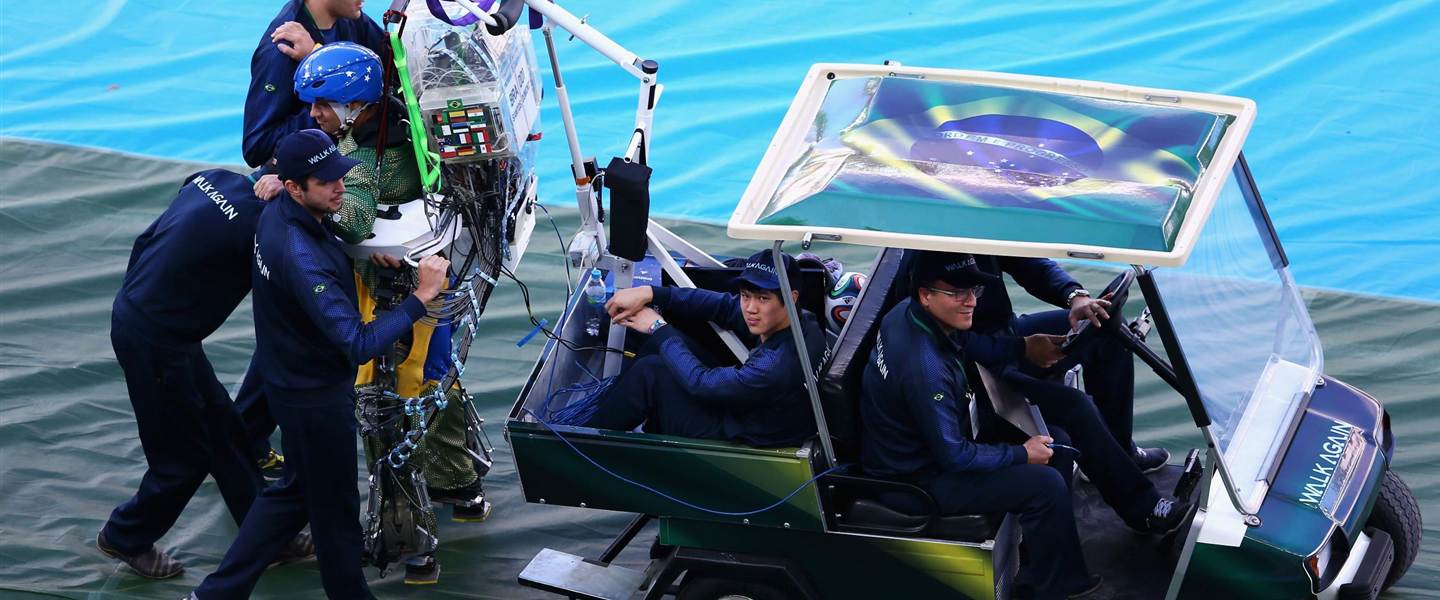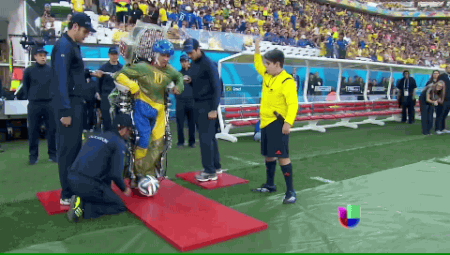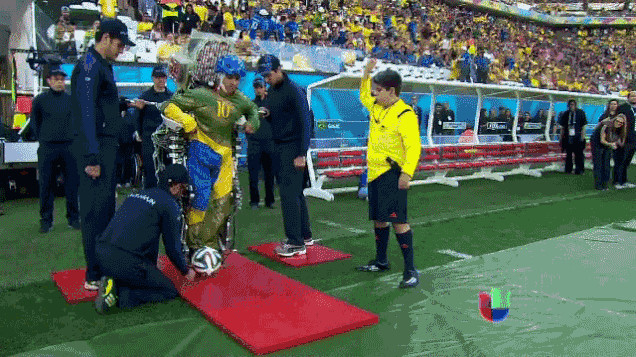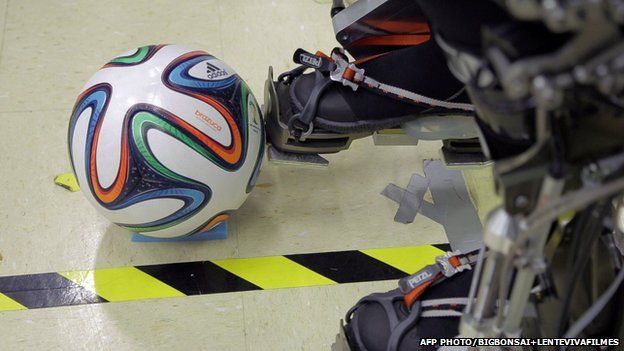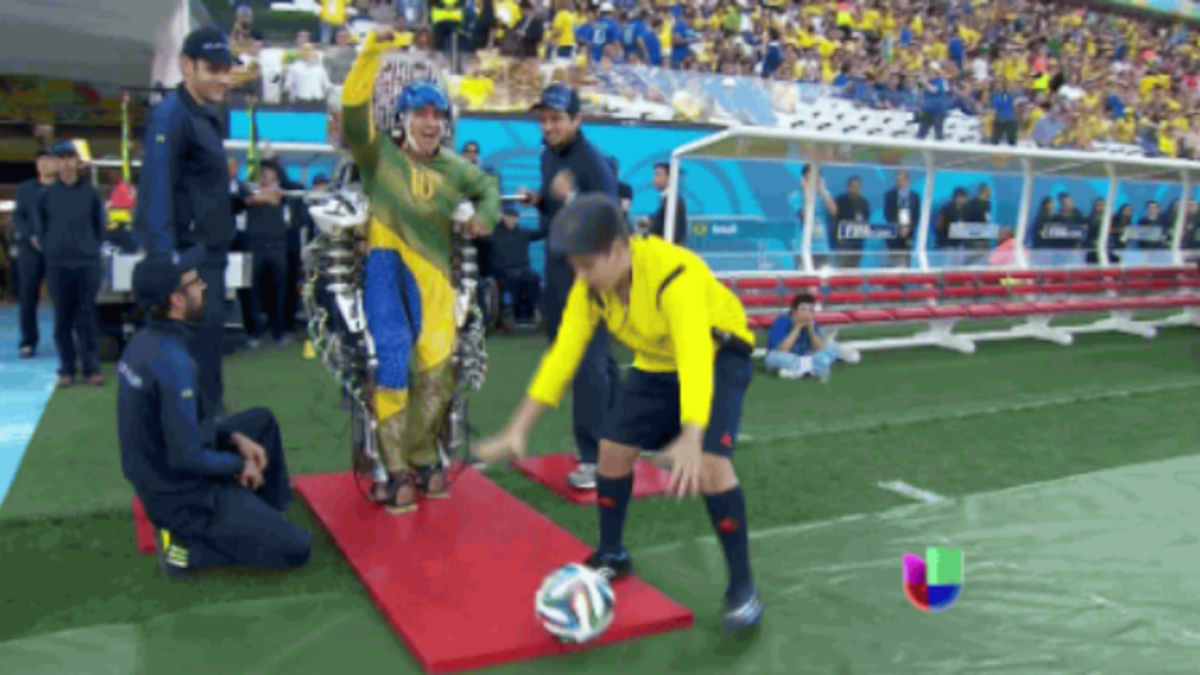How A 29-Year-Old Paraplegic Kicked Off The World Cup With His Mind
It may sound like a plot for an upcoming "Iron Man" movie, but instead it's the subject of our weekly FEEL GOOD FRIDAY this week. A 29-year-old paraplegic literally kicked off football's World Cup competition in Brazil on Thursday, using a mind-controlled exoskeleton.
Yesterday afternoon, the World Cup got its start with a particularly special kick: one from a paralysed volunteer wearing a robotic mind-controlled exoskeleton
The ambitious kick has been a long time in the making, with a whole group of volunteers training on the exoskeleton to make sure that there would be an operator skilled enough to pull off the tricky feat.
It was Juliano Pinto, a 29-year-old with complete paralysis of the lower trunk, who performed the symbolic kick-off at the Corinthians Arena in Sao Paulo
Juliano Pinto, seen here in the stadium, is completely paralysed in the lower trunk
Image via amazonaws.comUsing his robotic suit, Pinto kicked the official ball a short distance along a mat laid down by the touchline. But some observers argued the historic event was not given the attention it deserved during the opening ceremony. The identity of the young volunteer was kept a secret until after the event.
His robotic exoskeleton was created by a team of more than 150 researchers led by Brazilian neuroscientist Dr Miguel Nicolelis. "It was up to Juliano to wear the exoskeleton, but all of them made that shot. It was a big score by these people and by our science," Nicolelis commented.
Pinto is an athlete from Galea in Brazil's São Paulo State who lost the use of his legs after a car accident in 2006
Seven other paralyzed patients who volunteered to go through months of training for the task watched from the sidelines. "We did it!!!!" the project's leader, Duke University neuroscientist Miguel Nicolelis, tweeted.
Nicolelis spearheaded a team of more than 150 scientists to create the exoskeleton — an effort that he says cost the Brazilian government $14 million over the past two years.
Was Pinto's few seconds of fame worth the cost?
Probably not, if we're just talking about a kickoff that took a couple of seconds to complete. But the project's researchers said the advances made in the course of the years-long effort — and the exposure given to the next generation of brain-controlled prosthetics — could be priceless.
"The World Cup demonstration is ceremonial, as we have only a moment to show a kick. But maybe that kick will inspire a child somewhere in the world to become a doctor, engineer or scientist."
Sanjay Joshi, a roboticist from the University of California at Davis who was involved in the Walk Again Project, told NBC News via email from Brazil. Joshi said the project's long-term aim is to bring together neuroscience, engineering and medicine to build brain-controlled devices that can change the lives of paralyzed patients.
The suit that Pinto wore - how does it work?
Scientists work with a volunteer at neuroscientist Miguel Nicolelis' lab in Sao Paulo, Brazil, during the training period for the Walk Again Project kickoff.
Image via s-nbcnews.comThe system blends the hardware of a battery-powered "Iron Man" exoskeleton with a control system that's guided by brain waves. Pinto wore an electroencephalogram (EEG) cap dotted with electrodes, which picked up and magnified the faint electrical signals emanating through his skull. Sensors were built into the suit to detect muscle movements.
At first, Nicolelis considered using brain implants to control the suit, but he and his colleagues quickly determined that the EEG cap was less intrusive and more manageable.
During the training period, Pinto and the seven other subjects learned to think about moving their feet in such a way that the corresponding signals from their brains and muscles would register with the computerized guidance system. The exosuit's wearer received feedback from the feet in the form of buzzing vibrations felt on the skin. All eight patients learned to walk using the suit, and one overachiever took "a total of 132 steps, to the awe of everyone present."
At the World Cup ceremony, all it took was a tap from Pinto's robo-leg to send the soccer ball rolling
Meanwhile, assistants stood on either side, helping to steady the bulky suit. The moment passed so quickly that many TV viewers missed it.
